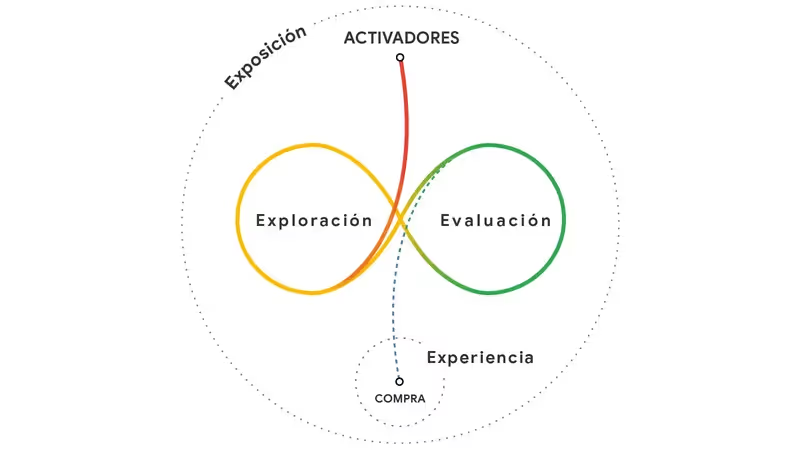How to attract consumers in their buying process?

The consumer decision-making process can be very complex to understand due to the many inputs that come to them. Google has released a report called “Decoding Decisions” which precisely speaks of the behavior of users when they must consider a brand in the digital world.
In this post we will comment on you How Google is understanding a user's change of choice when you should choose between one brand or another, and we'll give you tips to ensure that your visitors don't just arrive at your website, but that they convert.
El Customer Journey it's a complicated process from the moment the user starts looking for a product, until they actually decide. This process is not linear at all, nor is it a one-size-fits-all journey. This path is even more complicated if we are aware that each person is very different from another and has their own way of deciding.
Keys to understanding the consumer decision-making process
In 2019, Google decided to investigate the buying habits of users. The objective was to discover how people made the decision in the “messy middle”, which refers to a cluttered space where a lot of information and options aimed at the potential customer converge.
Faced with the various options presented to the consumer in this space, customers are deciding on one brand or another through the exploration and evaluation of information about the products as of the same brand. In this search spiral for references, we can find when, as a result of the search for a specific product, all the options that appear on the internet through social networks, reviews, search engines, blogs, and others are evaluated.

Source: Think with Google
Google suggests that consumers navigate within the messy middle, using cognitive biases that are rooted inside them. These biases are the same as those that have traditionally been used to academically investigate people's behaviors.
In this regard, Google discovered that when the user was in the middle of the messy middle, cognitive biases have an impact on their buying habits.
But what are these biases that influence customer decisions? While there are a lot of biases, Google highlights these 6 as the most relevant to consider:
- Category heuristics
A brief description of the product can simplify the user's decision-making process. - Power of Now
The shorter the user's wait time for a product, the better and more incentive it will encourage them to buy. - Social proof
The recommendations and reviews of others have a very positive effect. They bring confidence to the decision you may be about to make. - Feeling of scarcity
The product becomes more desired if it is perceived that the available units are decreasing or there are few that are on sale. - Authority Bias
If an expert gives a positive review, it gives credibility to the product or service. - The Power of Free
We are all attracted to free things, so offering one free product for the purchase of another can motivate the user to convert.
How to succeed in the messy middle?
Although we all have, to a greater or lesser extent, some notion of these biases that we just mentioned, Google has highlighted that it is very effective to work with these biases to be within the preferences of users.
Although the messy middle gives us the feeling that it is a complex and complicated space, for the consumer it only means buying a product or going on the Internet and carrying out a very everyday process. It's important that, if you're working in marketing, understand the relevance of these biases in the buying process and you can reach the user in a natural and strategically thought out way, so that you can clear up any possible doubts that may arise when making a decision.
Here are some of the recommendations that Google makes:
- Make sure that when users are looking for a product or service related to what you're offering, your brand is present. This way, you'll be present within their options to consider.
- Use the 6 biases in a responsible and intelligent way, so that you can reach them in a natural and attractive way.
- Try to reduce the steps from when you capture the future customer until the purchase is closed. The easier and more streamlined the process, the less chance you have of other brands capturing their attention.
- Coordinate your teams to respond to customer needs as quickly as possible, so as not to complicate the process even more.
To know the search intention of your users, behavioral analysis can be a very good complement to keyword research, since it can give you a very interesting and nutritious view for your campaigns.
As a starting point, you can be guided by these questions:
- What are people looking for?
- Are you there when potential customers are searching?
- What do users see on the search results page? Who and how do they appear?
- What is the user's behavior when they visit your website? What motivates them, where do they click, how far do they read and what pages do they visit the most?
- Have the 6 biases been taken into account in the campaigns you are running? How?
Analyzing and trying to answer these questions in relation to what customers do and should do on websites will help make a user more likely to convert.
If you need advice on how to increase conversions on your website or how to better reach your customer, write to us and we'll be happy to help.
How can we help you?
If you need more information, do not hesitate to contact contact us.
Cómo podemos ayudarte
Consulta los servicios con los que te ayudaremos a conseguir tus objetivos digitales.
